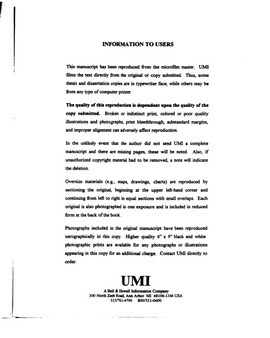| dc.contributor.advisor | Greenwald, Le, | en_US |
| dc.contributor.author | Jun, Woochun. | en_US |
| dc.date.accessioned | 2013-08-16T12:29:57Z | |
| dc.date.available | 2013-08-16T12:29:57Z | |
| dc.date.issued | 1997 | en_US |
| dc.identifier.uri | https://hdl.handle.net/11244/5592 | |
| dc.description.abstract | First, the dissertation discusses three important issues of concurrency control in OODBs. These include conflict among methods, class hierarchy locking, and nested method invocations. The previous works for each issue are presented, and their advantages and disadvantages are also discussed. Then, an integrated concurrency control which addresses all three issues is proposed. For conflict among methods, a finer locking granularity, such as an attribute and an individual class object, is adopted for instance access and class definition access so that higher concurrency is achieved. Especially, for instance access, higher concurrency is obtained using run-time information. Also, locks are required for instance method invocations instead of atomic operation invocations so that locking overhead is reduced. For class hierarchy locking, locking overheads are reduced using special classes which are based on access frequency information on classes. Finally, for nested method invocations, semantic information is used in order to provide higher concurrency among methods. Also, parent/children parallelism is adopted for better performance. | en_US |
| dc.description.abstract | Finally, a performance study is conducted by means of simulation using the 007 benchmark. The simulation results show that, in terms of transaction response time and lock waiting time, the proposed scheme performs the best, Malta the second best, and Orion the worst. | en_US |
| dc.description.abstract | Object-oriented databases (OODBs) have been adopted for non-standard applications requiring advanced modeling power, in order to handle complex data and relationships among such data. One of the important characteristics in database system is manipulation of shared data. That is, database systems, including OODBs, allow shared data to be accessed by multiple users at the same time. Concurrency control is a mechanism used to coordinate access to the multi-user databases so that the consistency of the database is maintained. In order to provide good performance, it is very important that concurrency control schemes incur low overhead and increase concurrency among users. This dissertation presents a concurrency control scheme in OODBs that meets those requirements. | en_US |
| dc.description.abstract | Secondly, an analytical model is constructed to measure the performance of concurrency control in an OODB system. Using this model, the proposed technique is then compared with the two existing techniques, Orion and Malta. The analytical results show that the proposed scheme gives the best transaction response time, Malta the second best, and Orion the worst. | en_US |
| dc.format.extent | xi, 213 leaves : | en_US |
| dc.subject | Parallel processing (Electronic computers) | en_US |
| dc.subject | Computer Science. | en_US |
| dc.subject | Object-oriented databases. | en_US |
| dc.subject | Paxton Boys | en_US |
| dc.title | An integrated concurrency control in object-oriented database systems. | en_US |
| dc.type | Thesis | en_US |
| dc.thesis.degree | Ph.D. | en_US |
| dc.thesis.degreeDiscipline | School of Computer Science | en_US |
| dc.note | Adviser: Le Greenwald. | en_US |
| dc.note | Source: Dissertation Abstracts International, Volume: 58-12, Section: B, page: 6665. | en_US |
| ou.identifier | (UMI)AAI9817724 | en_US |
| ou.group | College of Engineering::School of Computer Science | |
